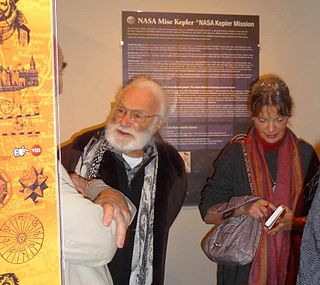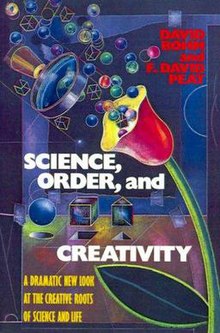Determinism is the philosophical belief that all events are determined completely by previously existing causes. Deterministic theories throughout the history of philosophy have sprung from diverse and sometimes overlapping motives and considerations. The opposite of determinism is some kind of indeterminism or randomness. Determinism is often contrasted with free will.
An interpretation of quantum mechanics is an attempt to explain how the mathematical theory of quantum mechanics "corresponds" to reality. Although quantum mechanics has held up to rigorous and extremely precise tests in an extraordinarily broad range of experiments, there exist a number of contending schools of thought over their interpretation. These views on interpretation differ on such fundamental questions as whether quantum mechanics is deterministic or random, which elements of quantum mechanics can be considered "real", and what is the nature of measurement, among other matters.

Synchronicity is a concept, first introduced by analytical psychologist Carl Jung, which holds that events are "meaningful coincidences" if they occur with no causal relationship yet seem to be meaningfully related. During his career, Jung furnished several different definitions of it. Jung defined synchronicity as an "acausal connecting (togetherness) principle," "meaningful coincidence", and "acausal parallelism." He introduced the concept as early as the 1920s but gave a full statement of it only in 1951 in an Eranos lecture.

David Joseph Bohm was an American scientist who has been described as one of the most significant theoretical physicists of the 20th century and who contributed unorthodox ideas to quantum theory, neuropsychology and the philosophy of mind.
Bohm Dialogue is a freely flowing group conversation in which participants attempt to reach a common understanding, experiencing everyone's point of view fully, equally and nonjudgementally. This can lead to new and deeper understanding. The purpose is to solve the communication crises that face society, and indeed the whole of human nature and consciousness. It utilizes a theoretical understanding of the way thoughts relate to universal reality. It is named after physicist David Bohm who originally proposed this form of dialogue.

Karl H. Pribram was a professor at Georgetown University, in the United States, an emeritus professor of psychology and psychiatry at Stanford University and distinguished professor at Radford University. Board-certified as a neurosurgeon, Pribram did pioneering work on the definition of the limbic system, the relationship of the frontal cortex to the limbic system, the sensory-specific "association" cortex of the parietal and temporal lobes, and the classical motor cortex of the human brain. He worked with Karl Lashley at the Yerkes Primate Center of which he was to become director later. He was professor at Yale University for ten years and at Stanford University for thirty years.
Implicate order and explicate order are ontological concepts for quantum theory coined by theoretical physicist David Bohm during the early 1980s. They are used to describe two different frameworks for understanding the same phenomenon or aspect of reality. In particular, the concepts were developed in order to explain the bizarre behavior of subatomic particles which quantum physics struggles to explain.
Holism in science, or holistic science, is an approach to research that emphasizes the study of complex systems. Systems are approached as coherent wholes whose component parts are best understood in context and in relation to one another and to the whole.
Francis David Peat (Born 18 April 1938 Waterloo, England died 6 June 2017 in Pari Italy) was a holistic physicist and author who has carried out research in solid state physics and the foundation of quantum theory.
John Briggs is an American author and co-author of general audience nonfiction books in the fields of holistic physics; aesthetics in the arts; creativity, creative process, and consciousness studies. Emeritus Distinguished CSU Professor of Writing and Aesthetics at Western Connecticut State University, Briggs lives in Granville, Massachusetts, where he has served as a Selectman and a police officer.

The term Cartesian linguistics was coined with the publication of Cartesian Linguistics: A Chapter in the History of Rationalist Thought (1966), a book on linguistics by Noam Chomsky. The word "Cartesian" is the adjective pertaining to René Descartes, a prominent 17th-century philosopher. However, rather than confine himself to the works of Descartes, Chomsky surveys other authors interested in rationalist thought. In particular, Chomsky discusses the Port-Royal Grammar (1660), a book which foreshadows some of his own ideas concerning universal grammar.

Wholeness and the Implicate Order is a book by theoretical physicist David Bohm. It was originally published 1980 by Routledge, Great Britain.
The quantum mind or quantum consciousness is a group of hypotheses which proposes that classical mechanics cannot explain consciousness. It posits that quantum mechanical phenomena, such as quantum entanglement and superposition, may play an important part in the brain's function and could form the basis for an explanation of consciousness.
Total human ecosystem (THE) is an eco-centric concept.
Antony Valentini is a theoretical physicist and a professor at Clemson University. He is known for his work on the foundations of quantum physics.
The holomovement brings together the holistic principle of "undivided wholeness" with the idea that everything is in a state of process or becoming. In this interpretation of physics wholeness is not considered static, but as a dynamic interconnected process. The concept is presented most fully in Wholeness and the Implicate Order, published in 1980.
The Pari Center for New Learning is a non-profit educational center located in the village of Pari in Civitella Paganico of the Province of Grosseto, Italy. The center was directed by F. David Peat, who co-authored the book Science, Order, and Creativity with theoretical physicist David Bohm. The center has hosted, with the support of its renowned fellows from academia and the arts, the academy Accademia dei Pari. It hosts international conferences on the role of trust and ethics in the world of economics and business, and conferences on the relationship between religion and science.
Basil J. Hiley, is a British quantum physicist and professor emeritus of the University of London.
Paavo Pylkkänen is a Finnish philosopher of mind. He is an Associate Professor of Philosophy at the University of Skövde and a university lecturer in theoretical philosophy at the University of Helsinki. He is known for his work on mind-body studies, building on David Bohm's interpretation of quantum mechanics, in particular Bohm's view of the cosmos as an enfolding and unfolding whole including mind and matter.
Quantum social science is an emerging field of interdisciplinary research which draws parallels between quantum physics and the social sciences. Although there is no settled consensus on a single approach, a unifying theme is that, while the social sciences have long modelled themselves on mechanistic science, they can learn much from quantum ideas such as complementarity and entanglement. Some authors are motivated by quantum mind theories that the brain, and therefore human interactions, are literally based on quantum processes, while others are more interested in taking advantage of the quantum toolkit to simulate social behaviours which elude classical treatment. Quantum ideas have been particularly influential in psychology, but are starting to affect other areas such as international relations and diplomacy in what one 2018 paper called a "quantum turn in the social sciences".





